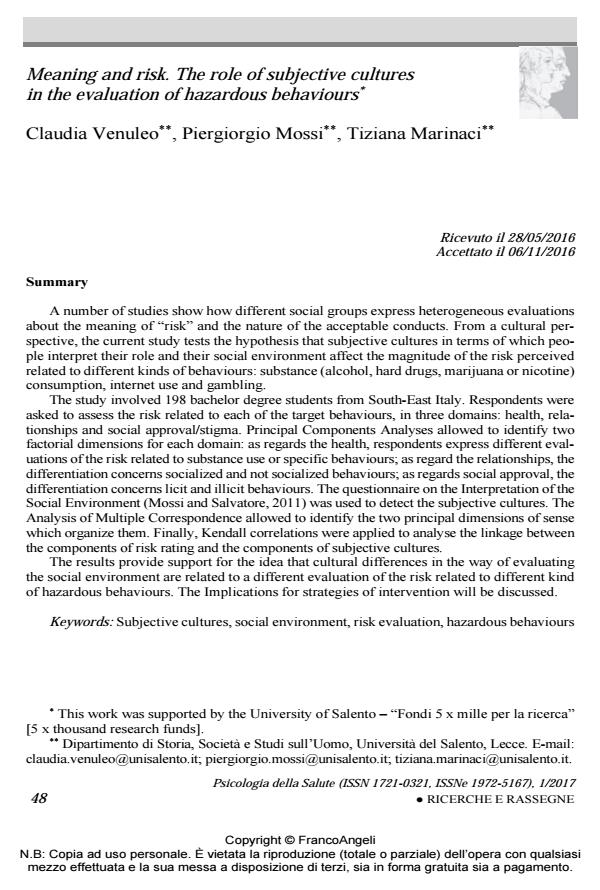Meaning and risk. The role of subjective cultures in the evaluation of hazardous behaviours
Titolo Rivista PSICOLOGIA DELLA SALUTE
Autori/Curatori Claudia Venuleo, Piergiorgio Mossi, Tiziana Marinaci
Anno di pubblicazione 2017 Fascicolo 2017/1
Lingua Inglese Numero pagine 28 P. 48-75 Dimensione file 266 KB
DOI 10.3280/PDS2017-001003
Il DOI è il codice a barre della proprietà intellettuale: per saperne di più
clicca qui
Qui sotto puoi vedere in anteprima la prima pagina di questo articolo.
Se questo articolo ti interessa, lo puoi acquistare (e scaricare in formato pdf) seguendo le facili indicazioni per acquistare il download credit. Acquista Download Credits per scaricare questo Articolo in formato PDF

FrancoAngeli è membro della Publishers International Linking Association, Inc (PILA)associazione indipendente e non profit per facilitare (attraverso i servizi tecnologici implementati da CrossRef.org) l’accesso degli studiosi ai contenuti digitali nelle pubblicazioni professionali e scientifiche
A number of studies show how different social groups express heterogeneous evaluations about the meaning of "risk" and the nature of the acceptable conducts. From a cultural perspective, the current study tests the hypothesis that subjective cultures in terms of which people interpret their role and their social environment affect the magnitude of the risk perceived related to different kinds of behaviours: substance (alcohol, hard drugs, marijuana or nicotine) consumption, internet use and gambling. The study involved 198 bachelor degree students from South-East Italy. Respondents were asked to assess the risk related to each of the target behaviours, in three domains: health, relationships and social approval/stigma. Principal Components Analyses allowed to identify two factorial dimensions for each domain: as regards the health, respondents express different evaluations of the risk related to substance use or specific behaviours; as regard the relationships, the differentiation concerns socialized and not socialized behaviours; as regards social approval, the differentiation concerns licit and illicit behaviours. The questionnaire on the Interpretation of the Social Environment (Mossi and Salvatore, 2011) was used to detect the subjective cultures. The Analysis of Multiple Correspondence allowed to identify the two principal dimensions of sense which organize them. Finally, Kendall correlations were applied to analyse the linkage between the components of risk rating and the components of subjective cultures. The results provide support for the idea that cultural differences in the way of evaluating the social environment are related to a different evaluation of the risk related to different kind of hazardous behaviours. The Implications for strategies of intervention will be discussed.
Diversi studi evidenziano come gruppi sociali differenti esprimano valutazioni eterogenee su cosa sia rischio e su quale sia la natura dei comportamenti accettabili. Inscrivendosi entro una prospettiva culturale, il presente studio verifica l’ipotesi che le culture soggettive con cui le persone interpretano il proprio ruolo e il proprio ambiente sociale impattano la grandezza del rischio percepito in relazione a differenti comportamenti: consumo di sostanze (alcol, droghe pesanti, marjuana o nicotina), uso di internet e gioco d’azzardo. Lo studio ha coinvolto 198 studenti universitari del sud-est di Italia. Ai rispondenti è stato chiesto di valutare il rischio connesso a ciascun comportamento target, in tre domini: salute, relazioni e approvazione/stigma sociale. L’Analisi in Componenti Principali ha consentito di identificare due dimensioni fattoriali per ciascun dominio: sul piano della salute, i rispondenti esprimono differenti valutazioni del rischio associato al consumo di sostanze o a determinati comportamenti; sul piano delle relazioni, le differen¬ziazioni concernono i comportamenti socializzati e non socializzati; sul piano dell’approvazione sociale, i comportamenti leciti o illeciti. Il questionario sull’Interpretazione dell’Ambiente Sociale (Mossi e Salvatore, 2011) è stato somministrato per rilevare le culture soggettive. L’Analisi delle Corrispondenze Multiple ha consentito di identificare le due principali dimensioni di senso che le caratterizzano. Infine, correlazioni di Kendall sono state usate per analizzare il rapporto tra le componenti di valutazione del rischio e le componenti delle culture soggettive. I risultati sostengono l’idea che differenze culturali nel modo di valutare l’ambiente sociale corrispondono a differenti valutazioni del rischio associato a differenti tipologie di comportamento. Saranno discusse le implicazioni per le strategie di intervento.
Parole chiave:Culture soggettive, ambiente sociale, valutazione del rischio, comportamenti a rischio
- Social Environment and Attitudes toward COVID-19 Anti-Contagious Measures: An Explorative Study from Italy Alessandro Gennaro, Matteo Reho, Tiziana Marinaci, Barbara Cordella, Marco Castiglioni, Cristina Liviana Caldiroli, Claudia Venuleo, in International Journal of Environmental Research and Public Health /2023 pp.3621
DOI: 10.3390/ijerph20043621 - What game we are playing: the psychosocial context of problem gambling, problem gaming and poor well-being among Italian high school students Tiziana Marinaci, Claudia Venuleo, Lucrezia Ferrante, Salvatore Della Bona, in Heliyon e07872/2021 pp.e07872
DOI: 10.1016/j.heliyon.2021.e07872 - Sex and Age Differences and Psychosocial Determinants of Regular Gambling: Insights from a Community-Based Study Claudia Venuleo, Domenico Cuzzola, Tiziana Marinaci, in European Journal of Investigation in Health, Psychology and Education /2025 pp.261
DOI: 10.3390/ejihpe15120261 - The Cardiac Rehabilitation Psychodynamic Group Intervention (CR-PGI): An Explorative Study Claudia Venuleo, Gianna Mangeli, Piergiorgio Mossi, Antonio F. Amico, Mauro Cozzolino, Alessandro Distante, Gianfranco Ignone, Giulia Savarese, Sergio Salvatore, in Frontiers in Psychology 976/2018
DOI: 10.3389/fpsyg.2018.00976 - The Meaning of Living in the Time of COVID-19. A Large Sample Narrative Inquiry Claudia Venuleo, Tiziana Marinaci, Alessandro Gennaro, Arianna Palmieri, in Frontiers in Psychology 577077/2020
DOI: 10.3389/fpsyg.2020.577077 - Is safety in the eye of the beholder? Discrepancies between self-reported and proxied data on road safety behaviors—A systematic review Sergio A. Useche, Mireia Faus, Francisco Alonso, in Frontiers in Psychology 964387/2022
DOI: 10.3389/fpsyg.2022.964387
Claudia Venuleo, Piergiorgio Mossi, Tiziana Marinaci, Meaning and risk. The role of subjective cultures in the evaluation of hazardous behaviours in "PSICOLOGIA DELLA SALUTE" 1/2017, pp 48-75, DOI: 10.3280/PDS2017-001003